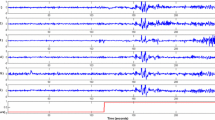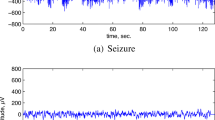Abstract
This paper describes a new method to identify seizures in electroencephalogram (EEG) signals using feature extraction in time–frequency distributions (TFDs). Particularly, the method extracts features from the Smoothed Pseudo Wigner-Ville distribution using tracks estimated from the McAulay-Quatieri sinusoidal model. The proposed features are the length, frequency, and energy of the principal track. We evaluate the proposed scheme using several datasets and we compute sensitivity, specificity, F-score, receiver operating characteristics (ROC) curve, and percentile bootstrap confidence to conclude that the proposed scheme generalizes well and is a suitable approach for automatic seizure detection at a moderate cost, also opening the possibility of formulating new criteria to detect, classify or analyze abnormal EEGs.






Similar content being viewed by others
References
Abásolo D, Escudero J, Hornero R, Gómez C, Espino P (2008) Approximate entropy and auto mutual information analysis of the electroencephalogram in Alzheimer’s disease patients. Med Biol Eng Comput 46:1019–1028
Acir N, Oztura I, Kuntalp M, Baklan B, Guzelis C (2005) Automatic detection of epileptiform events in EEG by three-stage procedure based on artificial neural networks. IEEE Trans Biomed Eng 52:30–40
Afonso VX, Tompkins WJ (1995) Detecting ventricular fibrillation. IEEE Eng Med Biol 14:152–159
Akay M (1996) Detection and estimation methods for biomedical signals. Academic Press, New Jersey
Auger F, Aldrin P, Goncalves P, Lemoine O (1996) Time–frequency toolbox for Matlab, user’s guide and reference guide. CNRS (France) and Rice University (USA), Paris
Barlow JS (1985) Methods of analysis of nonstationary EEGs, with emphasis on segmentation techniques: a comparative review. J Clin Neurophysiol 2:267–304
Blume WT, Young GB, Lemieux JF (1984) EEG morphology of partial epileptic seizures. Electroencephalogr Clin Neurophysiol 4:295–302
Boashash B (2003) Time frequency signal analysis and processing. A comprehensive reference. Elsevier, Oxford
Boashash B, Mesbah M (2001) A time–frequency approach for newborn seizure detection. IEEE Eng Med Biol Mag 20(5):54–64
Boashash B, Mesbah M (2002) Time–frequency methodology for newborn electroencephalographic seizure detection. In: Papandreou-Suppappola A (ed) Applications in time–frequency signal processing. CRC Press, Boca Raton, Florida
Boashash B, Carson H, Mesbah M (2000) Detection of seizures in newborns using time–frequency of EEG signals. Proceedings of Tenth IEEE workshop on statistical signal and array processing, pp 564–568
Cardoso JF (1998) Blind signal separation: statistical principles. Proc IEEE 86:2009–2025
Carmona RA, Hwang WL, Torrésani B (1999) Multiridge detection and time–frequency reconstruction. IEEE Trans Signal Process 47:480–492
Cohen L (1989) Time–frequency distributions—a review. Proc IEE 77:941–981
Cohen L (1995) Time–frequency analysis. Prentice Hall, Upper Saddle River, NJ
Colder BW, Frysinger RC, Wilson CL, Harper RM, et al (1996) Decreased neuronal burst discharge near site of seizure onset in epileptic human temporal lobes. Epilepsia 37:113–121
Durka PJ (1996) Time–frequency analysis of EEG. Thesis Institute of Experimental Physics, Warsaw University
Freeman WJ (1963) The electrical activity of a primary sensory cortex: analysis of EEG waves. Int Rev Neurobiol 5:53–119
Gonzalez B, Sanei S, Chambers JA (2003) Support vector machines for seizure detection. Proceedings of the IEEE ISSPIT, pp 126–129
Gotman J (1982) Automatic recognition of epileptic seizures in the EEG. Electroencephalogr Clin Neurophysiol 54:530–540
Gotman J (1983) Measurement of small time differences between EEG channels: methods and application to epileptic seizure propagation. Electroencephalogr Clin Neurophysiol 56:501–514
Grewal S, Gotman J (2005) An automatic warning system for epileptic seizures recorded on intracerebral EEGs. Clin Neurophysiol 116:2460–2472
Guerrero C, Malanda A, Iriarte J (2005) Time–frequency EEG analysis in epilepsy: what is more suitable? Proceedings of the IEEE ISSPIT, pp 202–207
Guerrero-Mosquera C, Navia Vazquez A (2009) Automatic removal of ocular artifacts from EEG data using adaptive filtering and independent component analysis. Proceedings of the 17th European signal processing conference (EUSIPCO), pp 2317–2321
Harrell FE (2001) Regression modeling strategies. Springer, New York
Hassanpour H, Mesbah M, Boashash B (2004) Time–frequency feature extraction of newborn EEG seizure using SVD-based techniques. Proceedings of EURASIP. J Appl Signal Process 16:2544–2554
He P, Wilson G, Russel C (2004) Removal of ocular artifacts from electro-encephalogram by adaptive filtering. Med Biol Eng Comput 42:407–412
Hinrikus H, Suhhova A, Bachmann M, et al (2009) Electroencephalographic spectral asymmetry index for detection of depression. Med Biol Eng Comput 47:1291–1299
Hlawatsch F, Boudreaux-Bartels GF (1992) Linear and quadratic time–frequency signal representation. IEEE SP Mag 9:21–67
Hoeve M, Zwaag BJ, Slump K, Jones R (2003) Detecting epileptic seizure activity in the EEG by independent component analysis. Proceedings of the ProRISC workshop on circuits systems and signal processing, pp 373–378
Iriarte J, Urrestarazu E, Valencia M, Alegre M, Malanda A, Viteri C, Artieda J (2003) Independent component analysis as a tool to eliminate artifacts in EEG: a quantitative study. J Clin Neurophysiol 20:249–257
Joyce CA, Gorodnitsky IF, Kutas M (2004) Automatic removal of eye movement and blink artifacts from EEG data using blind component separation. Psychophysiology 41:1–13
Kay SM, Marple SL (1981) Spectrum analysis: a modern perspective. Proc IEEE 69:1380–1419
Lehnertz K, Elger CE (1995) Spatio-temporal dynamics of the primary epileptogenic area in temporal lobe epilepsy characterized by neuronal complexity loss. Electroencephalogr Clin Neurophysiol 95:108–117
Le Van P, Urrestarazu E, Gotman J (2006) A system for automatic removal in ictal scalp EEG based on independent component analysis and Bayesian classification. Clin Neurophysiol 117:912–927
Li H, Sun Y (2005) The study and test of ICA algorithms. Proc IEEE Wirel Commun Netw Mob Comput 1:602–605
Lin Z-Y, Chen JDZ (1996) Advances in time–frequency analysis of biomedical signals. Crit Rev Biomed Eng 24:1–70
Makeig S, Bell AJ, Jung TP, Sejnowski T (1996) Independent component analysis of electroencephalogram data. Adv Neural Inf Process Syst 145–151
McAulay RJ, Quatieri TF (1986) Speech analysis/synthesis based on a sinusoidal representation. IEEE Trans Acoust Speech Signal Process 34:744–754
Mohseni HR, Maghsoudi A, Shamsollahi MB (2006) Seizure detection in EEG signals: a comparision of different approaches. Proceedings of the 28th IEEE annual EMBS international conference, pp 6724–6727
Muthuswamy J, Thakor NV (1998) Spectral analysis methods for neurological signals. J Clin Neurophysiol 83:1–14
Osorio I, Frei MG, Wilkinson SB (1998) Real-time automated detection and quantitative analysis of seizures and short-term prediction of clinical onset. Epilepsy 39:615–627
Rankine R, Mesbah M, Boashash B (2007) IF estimation for multicomponent signals using image processing techniques in the time–frequency domain. Signal Process 87:1234–1250
Sclabassi RJ, Sun M, Krieger DN, Scher MS (1990) Time–frequency analysis of the EEG signal. Proceedings of the international conference on signal processing, pp 935–938
Senhadji L, Wendling F (2002) Epileptic transient detection: wavelets and time–frequency approaches. Neurophysiol Clin 32:175–192
Swarnkar V, Abeyratne UR, Hukins C, Duce B (2009) A state transition-based method for quantifying EEG sleep fragmentation. Med Biol Eng Comput 47:1053–1061
Tognola G, Ravazzani P, Minicucci F, Locatelli T, et al (1996) Analysis of temporal non-stationarities in EEG signals by means of parametric modelling. Technol Health Care 4:169–185
Tseng SY, Chen RC, Chong FC, Kuo TS (1995) Evaluation of parametric methods in EEG signal analysis. Med Eng Phys 17:71–78
Tzallas AT, Tsipouras MG, Fotiadis DI (2007) The use of time–frequency distributions for epileptic seizure detection in EEG recordings. Proceedings of the IEEE EMBS, pp 3–6
Williams WJ, Zavery HP, Sackellares JC (1995) Time–frequency analysis in electrophysiology signals in epilepsy. IEEE Eng Med Biol 14:133–143
Acknowledgments
This work has been funded by the Spain CICYT grant TEC2008-02473.
Author information
Authors and Affiliations
Corresponding author
Rights and permissions
About this article
Cite this article
Guerrero-Mosquera, C., Malanda Trigueros, A., Iriarte Franco, J. et al. New feature extraction approach for epileptic EEG signal detection using time-frequency distributions. Med Biol Eng Comput 48, 321–330 (2010). https://doi.org/10.1007/s11517-010-0590-5
Received:
Accepted:
Published:
Issue Date:
DOI: https://doi.org/10.1007/s11517-010-0590-5




